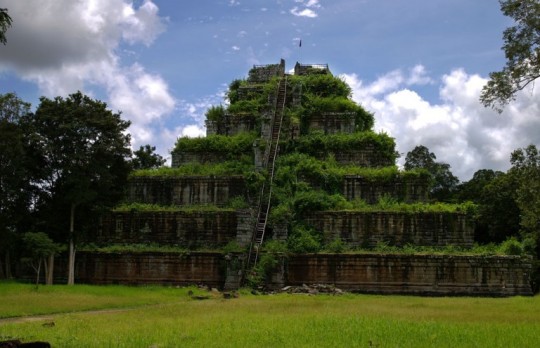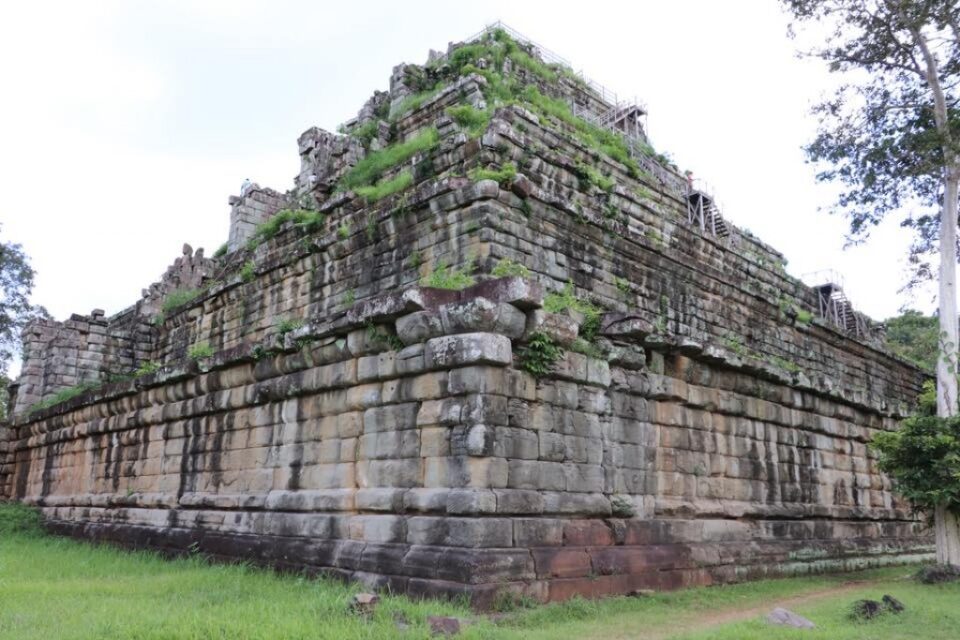Nowadays, Cambodia has three World Heritage sites such as Angkor (which was listed in 1992), Preah Vihear Temple (2008), and the Temple Zone of Sambor Prei Kuk, Archeological Site of Ancient Ishanapura (2017). Furthermore, it also has five areas of culture that are considered intangible cultural heritage including the Royal Ballet, the Shadow Puppet Theatre, the Tug of War, the Long Neck Lute (Chapei), and the Khmer Male Mask Dance Drama.

Koh Ker Temple Complex in Preah Vihear province is constituted as “one of the marvels of Cambodian monumental heritage” by UNESCO. The temple is located in Srayong commune, Kulen district, Preah Vihear province, about 120 km from Siem Reap.
It is a very jungle-filled region that is sparsely populated. More than 180 sanctuaries were found in a protected area of 81 square kilometers (31 sq mi). Koh Ker is located between the Kulen and Dangrek mountains and has scenery of rolling hills of varying heights ranging from 70 to 110 meters, making up the Steung Sen River watershed and producing a smooth slope from South to North.
Koh Ker Temple Complex in Ancient Time
Built by King Jayavarman IV (928-944), Koh Keh temple served as the national capital of the Khmer Empire. During his power, the Khmer Empire was at its most stable, allowing for cultural enlightenment. Jayavarman IV was willing to lift out regional, economic, social, and architectural advancement initiatives, urban planning, and rural infrastructure during this harmonized period.
More than that, Koh Ker’s art and architecture represent and support Jayavarman IV’s political viewpoint, mainly through the employment of a gigantic scale in building and dynamic sculptures, which are both unparalleled among other Khmer legacies.
In 944, according to UNESCO, Koh Ker was abandoned when King Rajendravarman moved his capital to today’s Angkor. Koh Ker was a cult site where Shiva had been worshipped for a long time. Also, Jayavarman IV was an ardent worshipper of this Hindu god.
As later kings (whose residence was not in Koh Ker) changed from Hinduism to Buddhism, they gave orders to make the necessary adjustments at their temples. Because of its remoteness, fortunately, the sanctuaries at Koh Ker were spared from these interventions.
Other Temples in Koh Ker Temple Complex
According to the Ministry of Culture and Fine Arts, the Koh Ker complex currently consists of 86 monuments. However, new temples have possibly been discovered, such as Prasat Thom Complex (ក្រុមប្រាសាទធំ), Andaung Preng Pond (ស្រះអណ្តូងប្រេង), Bak Temple (ប្រាសាទបាក់), Krachap temple (ប្រាសាទក្រចាប់), Srot Temple (ប្រាសាទស្រុត), Kok Krorng Temple (ប្រាសាទគោកគ្រោង), Kok Khmouch Temple (ប្រាសាទគោកខ្មោច), Banteay Pir Choan Temple (ប្រាសាទបន្ទាយពីរជាន់), Chambork Temple (ប្រាសាទចំបក់), Chamreh Temple (ប្រាសាទចំរេះ), Chen Temple (ប្រាសាទចិន), Chen Sram Temple or Choan Sram Temple (ប្រាសាទចិនស្រម ឬប្រាសាទជាន់ស្រាំ ឬប្រាសាទព្រៃវែង), Chrabb Temple (ប្រាសាទច្រាប), Damrei Temple (ប្រាសាទដំរី), Kdak Temple or Po Damnak temple (ប្រាសាទក្តាក់), Pram temple (ប្រាសាទប្រាំ), Rahal (រហាល), Khnar Sen Keo temple (ប្រាសាទត្រពាំងខ្នារសែនកែវ ឬប្រាសាទខ្នារសែនកែវ), Dang Tung Temple (ប្រាសាទដងទង់), Reamker Temple (ប្រាសាទរាមកេរ្តិ៍), Dei Chhnang Temple (ប្រាសាទដីឆ្នាំង), Ktum Temple (ប្រាសាទក្ទម្ព ឬប្រាសាទនាងខ្ទុំ), and so on.
These structures were not built at close distance to one another. Many of these ancient monuments are either broken or buried in the ground.
Ways To Go Koh Ker Temple Complex
You’ll need to hire a private taxi to go to Koh Ker. Driving from Siem Reap, you’ll see banana and cashew plantations and rice farms on your 2.5-hour journey. You may easily incorporate a journey to Koh Ker and Beng Mealea with the Kulen mountain path.
Koh Ker is a new spot for tourist destinations. Restaurants, drink stalls, and a small variety of market booths offering fresh coconut juices, and you can find handicrafts inside the parking park at Koh Ker. Sadly, the restrooms are not yet available at this location.
When is The Best Time To Visit?
Because trees do not shelter the pyramid and its levels, morning visits provide some break from the sun’s sweltering rays. Reap the benefits of the cooler temperatures in Koh Ker first, then go to Beng Mealea just as the major tour groups are finishing their lunch break. This way, you may avoid the crowds at Beng Mealea. Even at the busiest time of year, you won’t find a big number of people here, so you may take your time exploring the location from May to November when it’s less crowded.
For further insights of the complex, please access via Koh Ker: Archaeological Site of Ancient Lingapura or Chok Gargyar
Gallery





